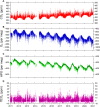Novel quantification of regional fossil fuel CO2 reductions during COVID-19 lockdowns using atmospheric oxygen measurements
- PMID: 35452281
- PMCID: PMC9032948
- DOI: 10.1126/sciadv.abl9250
Novel quantification of regional fossil fuel CO2 reductions during COVID-19 lockdowns using atmospheric oxygen measurements
Abstract
It is not currently possible to quantify regional-scale fossil fuel carbon dioxide (ffCO2) emissions with high accuracy in near real time. Existing atmospheric methods for separating ffCO2 from large natural carbon dioxide variations are constrained by sampling limitations, so that estimates of regional changes in ffCO2 emissions, such as those occurring in response to coronavirus disease 2019 (COVID-19) lockdowns, rely on indirect activity data. We present a method for quantifying regional signals of ffCO2 based on continuous atmospheric measurements of oxygen and carbon dioxide combined into the tracer "atmospheric potential oxygen" (APO). We detect and quantify ffCO2 reductions during 2020-2021 caused by the two U.K. COVID-19 lockdowns individually using APO data from Weybourne Atmospheric Observatory in the United Kingdom and a machine learning algorithm. Our APO-based assessment has near-real-time potential and provides high-frequency information that is in good agreement with the spread of ffCO2 emissions reductions from three independent lower-frequency U.K. estimates.
Figures





References
-
- IEA, International Energy Agency World Energy Outlook 2008 (2008), chap. 8, pp. 179–193 .
-
- Peters G. P., le Quéré C., Andrew R. M., Canadell J. G., Friedlingstein P., Ilyina T., Jackson R. B., Joos F., Korsbakken J. I., McKinley G. A., Sitch S., Tans P., Towards real-time verification of CO2 emissions. Nat. Clim. Chang. 7, 848–850 (2017).
-
- Le Quéré C., Jackson R. B., Jones M. W., Smith A. J. P., Abernethy S., Andrew R. M., De-Gol A. J., Willis D. R., Shan Y., Canadell J. G., Friedlingstein P., Creutzig F., Peters G. P., Temporary reduction in daily global CO2 emissions during the COVID-19 forced confinement. Nat. Clim. Chang. 10, 647–653 (2020).
-
- Liu Z., Ciais P., Deng Z., Lei R., Davis S. J., Feng S., Zheng B., Cui D., Dou X., Zhu B., Guo R., Ke P., Sun T., Lu C., He P., Wang Y., Yue X., Wang Y., Lei Y., Zhou H., Cai Z., Wu Y., Guo R., Han T., Xue J., Boucher O., Boucher E., Chevallier F., Tanaka K., Wei Y., Zhong H., Kang C., Zhang N., Chen B., Xi F., Liu M., Bréon F. M., Lu Y., Zhang Q., Guan D., Gong P., Kammen D. M., He K., Schellnhuber H. J., Near-real-time monitoring of global CO2 emissions reveals the effects of the COVID-19 pandemic. Nat. Commun. 11, 5172 (2020). - PMC - PubMed
-
- Friedlingstein P., O’Sullivan M., Jones M. W., Andrew R. M., Hauck J., Olsen A., Peters G. P., Peters W., Pongratz J., Sitch S., le Quéré C., Canadell J. G., Ciais P., Jackson R. B., Alin S., Aragão L. E. O. C., Arneth A., Arora V., Bates N. R., Becker M., Benoit-Cattin A., Bittig H. C., Bopp L., Bultan S., Chandra N., Chevallier F., Chini L. P., Evans W., Florentie L., Forster P. M., Gasser T., Gehlen M., Gilfillan D., Gkritzalis T., Gregor L., Gruber N., Harris I., Hartung K., Haverd V., Houghton R. A., Ilyina T., Jain A. K., Joetzjer E., Kadono K., Kato E., Kitidis V., Korsbakken J. I., Landschützer P., Lefèvre N., Lenton A., Lienert S., Liu Z., Lombardozzi D., Marland G., Metzl N., Munro D. R., Nabel J. E. M. S., Nakaoka S. I., Niwa Y., O’Brien K., Ono T., Palmer P. I., Pierrot D., Poulter B., Resplandy L., Robertson E., Rödenbeck C., Schwinger J., Séférian R., Skjelvan I., Smith A. J. P., Sutton A. J., Tanhua T., Tans P. P., Tian H., Tilbrook B., van der Werf G., Vuichard N., Walker A. P., Wanninkhof R., Watson A. J., Willis D., Wiltshire A. J., Yuan W., Yue X., Zaehle S., Global carbon budget 2020. Earth Syst. Sci. Data 12, 3269–3340 (2020).
LinkOut - more resources
Full Text Sources

